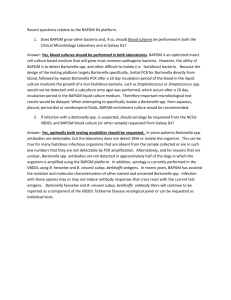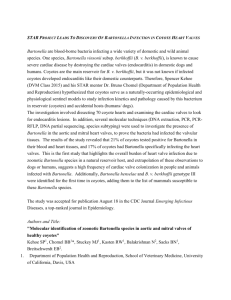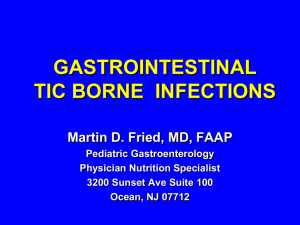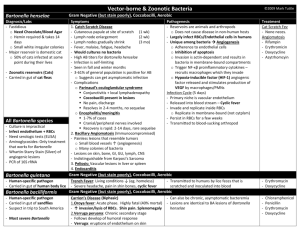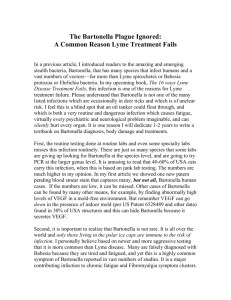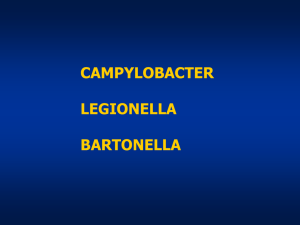Original Article - James L. Schaller, M.D., M.A.R., P.C
advertisement
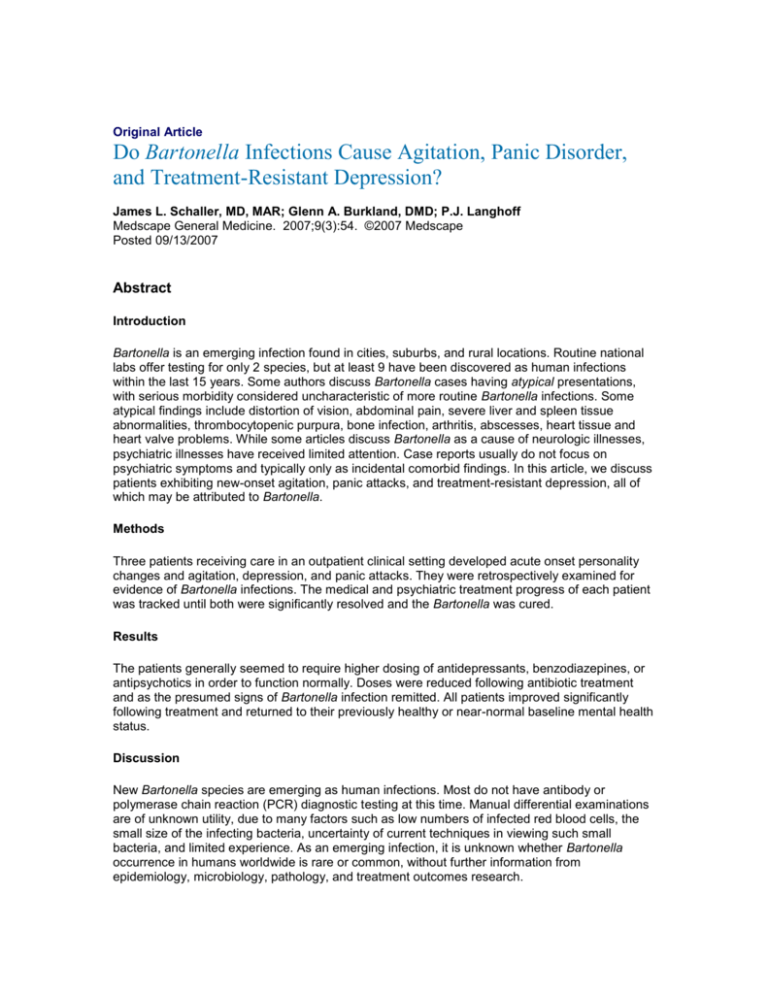
Original Article Do Bartonella Infections Cause Agitation, Panic Disorder, and Treatment-Resistant Depression? James L. Schaller, MD, MAR; Glenn A. Burkland, DMD; P.J. Langhoff Medscape General Medicine. 2007;9(3):54. ©2007 Medscape Posted 09/13/2007 Abstract Introduction Bartonella is an emerging infection found in cities, suburbs, and rural locations. Routine national labs offer testing for only 2 species, but at least 9 have been discovered as human infections within the last 15 years. Some authors discuss Bartonella cases having atypical presentations, with serious morbidity considered uncharacteristic of more routine Bartonella infections. Some atypical findings include distortion of vision, abdominal pain, severe liver and spleen tissue abnormalities, thrombocytopenic purpura, bone infection, arthritis, abscesses, heart tissue and heart valve problems. While some articles discuss Bartonella as a cause of neurologic illnesses, psychiatric illnesses have received limited attention. Case reports usually do not focus on psychiatric symptoms and typically only as incidental comorbid findings. In this article, we discuss patients exhibiting new-onset agitation, panic attacks, and treatment-resistant depression, all of which may be attributed to Bartonella. Methods Three patients receiving care in an outpatient clinical setting developed acute onset personality changes and agitation, depression, and panic attacks. They were retrospectively examined for evidence of Bartonella infections. The medical and psychiatric treatment progress of each patient was tracked until both were significantly resolved and the Bartonella was cured. Results The patients generally seemed to require higher dosing of antidepressants, benzodiazepines, or antipsychotics in order to function normally. Doses were reduced following antibiotic treatment and as the presumed signs of Bartonella infection remitted. All patients improved significantly following treatment and returned to their previously healthy or near-normal baseline mental health status. Discussion New Bartonella species are emerging as human infections. Most do not have antibody or polymerase chain reaction (PCR) diagnostic testing at this time. Manual differential examinations are of unknown utility, due to many factors such as low numbers of infected red blood cells, the small size of the infecting bacteria, uncertainty of current techniques in viewing such small bacteria, and limited experience. As an emerging infection, it is unknown whether Bartonella occurrence in humans worldwide is rare or common, without further information from epidemiology, microbiology, pathology, and treatment outcomes research. Conclusion Three patients presented with acute psychiatric disorders associated with Bartonella-like signs and symptoms. Each had clear exposure to ticks or fleas and presented with physical symptoms consistent with Bartonella, eg, an enlarged lymph node near an Ixodes tick bite and bacillary angiomatosis found only in Bartonella infections. Laboratory findings and the overall general course of the illnesses seemed consistent with Bartonella infection. The authors are not reporting that these patients offer certain proof of Bartonella infection, but we hope to raise the possibility that patients infected with Bartonella can have a variety of mental health symptoms. Since Bartonella can clearly cause neurologic disorders, we feel the presence of psychiatric disorders is a reasonable expectation. Reader Comments on: Do Bartonella Infections Cause Agitation, Panic Disorder, and TreatmentResistant Depression? See reader comments on this article and provide your own. Readers are encouraged to respond to the author at jschaller@embarqmail.com or to Paul Blumenthal, MD, Deputy Editor of MedGenMed, for the editor's eyes only or for possible publication as an actual Letter in MedGenMed via email: pblumen@stanford.edu Introduction Bartonella is an infection that may cause a rash, enlarged lymph node(s), and malaise and fatigue that resolve over several weeks.[1,2] Many animals and insects carry this infection. Bartonella has multiple vectors and infection sources including fleas, flea feces, cat licks or scratches, ticks, lice, and biting flies.[3-6] Young stray kittens are often able to infect humans due to flea feces on their paws, or through cat scratches, bites, or licks.[7-10] Bartonella is found in cities, suburbs, and rural locations,[11-14] and is an emerging infection. In recent decades, Bartonella research publications are increasing, but psychiatric disorders were underreported in the soldiers of World War I and World War II. For example, approximately 1 million soldiers in WWI were affected with Bartonella quintana,[15] but medical journals did not report much about its psychiatric manifestations. In the last 15 years, 9 Bartonella bacteria have been identified that are known to infect humans: B henselae, B elizabethae, B grahamii, B vinsonii subsp. arupensis, B vinsonii subsp. berkhoffii, B grahamii, B washoensis, and, more recently, B koehlerae and B rochalimae.[16-20] Currently, the largest national laboratories offer tests for only 2 species [21-23] (B quintana and B henselae). Some Bartonella cases have "atypical" presentations with signs or symptoms lasting more than weeks, causing diverse medical problems. For example, Bartonella can cause vision abnormalities, prolonged fever, joint pain, lung inflammation, respiratory disease, and granulomas throughout the body. It can occasionally cause abdominal pain, liver and spleen tissue abnormalities, thrombocytopenic purpura, bone infection, papules or pustules, maculopapular rashes, arthritis, abscesses,[20, 24-30] heart tissue and heart valve problems,[31-37] and neurologic illnesses.[38-42] Traditionally, cognitive neurology has been related to some psychiatric illnesses. A search of PubMed with "Bartonella" and the search words "depression," "mania," "bipolar," "major depression," "depression," "anxiety," "panic," "panic attack," "psychosis," and "schizophrenia" yielded the limited journal results below: Depression Dementia Encephalopathy Violent behavior Confusion Combative behavior Substance abuse disorders[43-48] Some articles link Bartonella to substance abuse. Bartonella is repeatedly linked with alcoholism in the presence of substandard living conditions. Intravenous drug users also have an elevated prevalence of antibodies to Bartonella organisms and may be at significant risk of becoming infected.[49-53] The 3 cases described below are consistent with past reports of Bartonella causing psychiatric symptoms, and add further clinical data to these past reports. Case 1 A 41-year-old male minister was reported by his wife, best friends, and children to have undergone a personality change after a camping trip in North Carolina. After the trip, the patient described a small right-sided "aching" axillary lymph node and reported a "fever." He removed 3 Ixodes deer ticks from his leg and shoulder. Five weeks later, he had an "enlarged and very annoying" right-sided axillary lymph node, "excessive warmth," irritability, severe insomnia, and new-onset eccentric rage. He had new excess sensitivity to slightly annoying smells and sounds. His afternoon temperatures were 98.7-99.9°F, which he recorded every 3 days. The patient tested negative for Lyme disease using the Centers for Disease Control and Prevention (CDC) 2-tier surveillance testing procedure performed at Quest Diagnostics, and yet Bartonella was suspected from his unilateral lymph node symptom and Ixodes attachment. The duration of the lymph node ache was at least 5 weeks, so "atypical" Bartonella was considered in the differential. The patient was ordered an IgG and IgM B henselae along with other lab testing. The only positive result was an IgM of 1:256. A PCR test for 2 Bartonella species was negative, but positive for B henselae when repeated. During the next 2 weeks, the patient developed serious agitation, panic attacks, and major depression. His major depression was quantified by the Inventory to Diagnose Depression (IDD) scale.[54-56] His IDD was 39. This is in the moderate to severe range, so he was diagnosed with major depression (MD). He also was found to have excess anxiety with a 29 on the Beck Anxiety Inventory (BAI) scale, using 0-7 as a functional normal range. (Judith Beck, personal communication, 1994).[57-59] He was so agitated that during arguments with his spouse, he threw objects such as kitchen glasses, a baseball, and a chair into his home's drywall. Previously he was unknown to use insults or to curse at people, and now he did both almost daily. He slept 8-9 hours per day, ate normally, and had normal speech speed and enunciation patterns. A psychiatrist diagnosed him as having bipolar disorder, despite the fact that he had no genetic history or any previous history of depression or mania. The patient gained 15 pounds in 3 weeks on 1250 mg per day of valproic acid, so he was tried on lithium carbonate, 300 mg at breakfast, lunch and dinner, with 600 mg once in the evening (blood level 1.1 mEq/L). These medications had no clear clinical effect on the patient's agitation, mood extremes, or anhedonia with hopelessness. They were stopped after a minimum of 3-week trials. A trial of quetiapine at 12.5 mg in the morning, afternoon, and 50 mg at bedtime helped significantly for 3 weeks, but then the drug stopped controlling his agitation and other dysfunctional behaviors. A higher dose of 25 mg of quetiapine in the morning, 25 mg in the afternoon, and 100 mg at bed was successful. The patient surprisingly reported that he felt "good" and "content" on this medication at these doses. At this point, the patient still had a large tender unilateral lymph node, fatigue, and new papules under his right arm. Various causes of persistent large unilateral lymph nodes with papules were felt to fit a diagnosis of Bartonella. Based on a consult with an infectious disease physician, the patient was treated with azithromycin 250 mg twice daily and rifampicin 300 mg twice daily with food for 2 weeks. The patient's anxiety increased, and he experienced 5 panic attacks. He became psychiatrically worse: highly reactive, emotionally volatile, and markedly irritable. His quetiapine was increased to 50 mg at breakfast and lunch, and 200 mg once in the evening, with immediate control of his increased morbidity. After 5 weeks on this dual-antibiotic treatment, the patient began to exhibit sleepiness. His quetiapine dose was reduced to 25 mg at breakfast and 75 mg at bedtime, with no return of agitation or mood lability. He was still complaining, however, of right-sided axillary lymph node symptoms, so he was treated for another 3 weeks on these antibiotics. A medical literature review of PubMed looking for the ideal dose of antibiotics and duration of treatment for this suspected Bartonella infection offered no uniform results. However, the patient's lymph node complaints ended abruptly following 8 weeks of antibiotics, and so his medications were stopped. The patient's psychiatric symptoms have significantly improved, and he now remains on escitalopram 5 mg and quetiapine 6.5 mg in the morning and 25 mg qhs. His personality is felt to be 90% of baseline, according to his spouse and closest friend. We suggest this man's psychiatric problems support a Bartonella presentation. Specifically, his symptoms immediately followed a clear Ixodes attachment, a new unilateral and uncomfortable axillary lymph node appeared just after this attachment, new papules formed, and he experienced a new constant "slight fever" feeling, a low-positive Bartonella serology result, conflicting PCR results, and a positive response to 2 antibiotics from medication classes that are believed to be effective in vivo against Bartonella. Further, his emotional improvement occurred nearly simultaneous to his enlarged lymph node normalization. Case 2 Following the adoption of 2 young cats from a shelter, a medical student reported an "unusual rash" on her thighs, consisting of 4 linear lines measuring 4-9 cm, each 0.5-1.0 cm in width, running from the top of her thigh distally. These rashes were eventually determined to be bacillary angiomatosis by a dermatologist, following the elimination of a number of other possible causes, such as Cushing's syndrome, Kaposi's sarcoma, and an HIV infection. The patient had significant risk factors for Bartonella including adoption of kittens from a shelter. She reported a number of flea bites, having "flea-bombed" her apartment 2 times within the past year, and she also allowed her cats to sleep in her bed. She explained that her cats routinely licked her hands, occasionally licked her mouth, and scratched and routinely gently bit her when playing. The patient complained of new panic attacks, profound restlessness, and depression that began around the time of her new thigh rashes. She failed to receive benefit from routine doses of benzodiazepines or standard doses of selective serotonin reuptake inhibitors. She refused a trial of tricyclic antidepressants due to cardiac concerns, and she refused a trial of mirtazapine due to weight concerns. She rejected transdermal selegiline and bupropion due to the likelihood of an absence of anxiety benefit. The only treatments showing modest benefit (30%-40%) for this patient were escitalopram at a dose gradually increased to 30 mg per day, which is above US Food and Drug Administrationapproved dosing and higher than the dosing recommended on the basis of most research on the medication, but this dose decreased her hopelessness compared with a 3-week 20-mg trial. Her IDD dropped from 34 to 23 on escitalopram on 30 mg per day. She also self-administered SAM-e (S-adenosylmethionine) at 600 mg every morning. This latter dose is below the routine dose for the treatment of major depression, which is 1200-1600 mg per day when dosed orally. The patient felt this was "helpful" for decreasing her depression.[60-65] The patient was warned of seizure and serotonin syndrome risks with the use of 2 antidepressants, including 1 at very high dosing, but lower doses of escitalopram felt like "nothing was happening," and she wanted doses that had benefits.[66,67] Over 8 weeks, an increase of escitalopram decreased her residual moderate depression. She was increased to escitalopram 60 mg and SAM-e 1200 mg over 10 weeks, which resulted in a 90% remission of her depression. She had no serotonin symptoms such as myoclonus, rigidity, hyperreflexia, shivering, confusion, agitation, restlessness, blood pressure instability, fever, nausea, diarrhea, diaphoresis, flushing, or rhabdomyolysis. She did have some residual anxiety, and this was treated with clonazepam 2 mg, 1 tablet once in the morning and afternoon, and 2 qhs, with no sedation side effects. She still had clear information-processing limitations, markedly poor memory, and the unusual need for high psychiatric dosing to gain any benefit. Her psychiatrist noted, "She may have a diffuse brain disorder, ie, undiagnosed inflammation or infectious source. Her unusual color thigh rash images seem important." The patient's nurse practitioner had seen a case of cat scratch fever in the past, and hypothesized that the patient had bacillary angiomatosis from Bartonella -the infectious cause of cat scratch fever. The patient was placed on cefuroxime 250 mg twice a day and azithromycin 250 mg 3 times a day. During Week 1, the patient became increasingly sad, irritable, and hopeless, with increased panic attacks that an increase in clonazepam did not relieve. However, by Week 2 she seemed to have less depression and agitation. Surprisingly, during Week 3, on approximately Day 16, her reddish thigh rashes were gone, with residual normal skin color with irregular patterning. Over 8 weeks, the patient's depression and anxiety improved. She tolerated a sharp reduction in both of her medications, ie, escitalopram was lowered to 25 mg per day with a decrease of clonazepam to 1 mg once every morning, afternoon, and evening. She stopped her SAM-e entirely. She was regarded as medically cured and only scheduled for routine gynecologic exams. After 6 months, the bacillary angiomatosis returned approximately 50%, and the patient reported a moderate return of inappropriate anger, excess interpersonal sensitivity, severe premenstrual dysphoric disorder, irritability, and sadness. She was regarded by her physician as having a Bartonella relapse and placed on rifampicin 300 mg 3 times per day, and cefdinir 300 mg 3 times per day for 12 weeks. He then replaced the cefdinir with azithromycin 500 mg at 1½ tablets a day for 6 weeks. After this treatment, the patient was back at her baseline and now only takes escitalopram 10 mg per day, with clonazepam 0.5 mg in the morning and 0.75 mg once in the evening -- a fraction of the earlier doses. The family physician feels that the antibiotics were helpful, but is still uncertain of the "best" antibiotic protocol for Bartonella, based on his review of infection handbooks and Medline articles. Case 3 A businessman from the Midwest reported failing treatment for new adult-onset social anxiety, generalized anxiety disorder, panic attacks, and MD. His IDD depression scores were 34 and 40 taken twice over the same intake week. His BAI was 29. He also had a new, moderately severe daily headache. He had been fine psychiatrically until he went on a camping and hunting trip in Florida a couple of months earlier. Following that, he experienced "flu" and "feverish" feelings for about 9 days. He also developed 3 new skin-colored papules under his left arm. He had no rashes, tick attachments, clear flea exposures, or dog or cat contact. However, he reported extensive contact with wild bush branches and leaves while hunting and walking in the woods. He also reported that he virtually never checked himself for ticks. His camping partner was bitten by a lone star tick and treated immediately with antibiotics for Lyme or Masterson's disease, based upon history, location, type of tick, and a new oval, pink, homogeneous ankle rash. Our patient failed both Lab Corp ELISA and Western blot testing for Lyme according to CDC surveillance criteria, but showed a 23 band on the IgM Western blot. His manual differential blood smear reported coccobacilli attached to some red blood cells (RBCs), a rare ability for bacteria, but found in some American Bartonella species infections. The patient was negative for a Bartonella PCR, but positive for an IgG titer at 1:128. A review of some Medline articles showed the internist that Bartonella PCR testing is not always reliable. Other articles showed a high degree of reliability. He decided to treat for Bartonella based on the patient's high tick exposure, his friend's tick infection, the patient's 3 new papules, the manual blood smear, and his abnormal antibody titer. The internist treated the patient with doxycycline 100 mg twice a day for 3 weeks with no benefit other than a slight reduction in headaches. He then treated him with rifampicin 300 mg twice daily combined with trimethoprim-sulfamethoxazole at a dose of 160 mg/800 mg twice a day for 1 month. The patient had a marked benefit from this last treatment and returned approximately 85% to his psychiatric baseline. He no longer exhibited any social anxiety, generalized anxiety disorder, or panic attacks. His MD was only mild with an IDD of 12 (borderline normal), and he was treated daily with 100 mg of sertraline. After approximately 14 months, the patient was in a severe motor vehicle accident and required hospitalization and multiple surgeries to regain his stability. Approximately 7-12 weeks after his accident, he began to have a resurgence of all of his psychiatric symptoms. His physician diagnosed a Bartonella relapse causing a psychiatric relapse. The patient was placed on rifabutin 300 mg daily with azithromycin 250 mg twice a day. Over 4-5 weeks, his psychiatric symptoms improved approximately 50%, so he was treated for an additional 5 weeks with remission of all psychiatric symptoms except depression, which was being treated with 100 mg of sertraline. His sertraline blood level was checked, and his steadystate sertraline level had decreased over time, so his dose was increased from 100 mg to 150 mg per day, which restored him to a normal mood. Results The previously discussed patients with presumed Bartonella seemed to generally require higher dosing of antidepressants, benzodiazepines, or the use of antipsychotics in order to function normally. Doses could be reduced as the presumed signs of Bartonella infection remitted following antibiotic treatment. All patients improved significantly and nearly achieved their normal, healthy baseline mental health status. Discussion Bartonella with psychiatric symptoms is rarely discussed in the medical literature. In this article, we have presented case studies of patients with new clear psychiatric morbidity, sudden agitation, panic attacks, and treatment-resistant depression, all possibly attributed to Bartonella. Reasonably compelling and broad data provided evidence for inclusion in this article and included: exposure to endemic areas and endemic animals such as young cats, clear tick bites or probable flea transmission, abnormal lymph nodes, a "fever," a positive antibody test, an eventually positive PCR, axillary papules, bacillary angiomatosis rashes, the unusual need for high psychiatric dosing to gain any benefit, information-processing limitations, poor memory, and a new, moderately severe daily headache. The presence of Bartonella-induced psychiatric symptoms should not be surprising. First, psychiatric disorders are brain disorders, and Bartonella is documented as causing many diverse neurologic brain disorders. Second, Bartonella infections are associated with RBCs, which allow small Bartonella bacteria (a fraction of the RBC size) to enter the brain's vascular system. [68-83] These Bartonella-infected RBCs probably cause psychiatric morbidity due to brain pathology, as indicated by the fact that some Bartonella patients have neurologic disorders, such as seizures, hemiplegia, ischemic strokes, transverse myelitis, and multiple granulomatous lesions, as well as meningitis and encephalitis.[38,84,85] Finally, with 9 species or subspecies that can infect humans, it is possible this larger number of species can produce a wider range of signs and symptoms -- some of which might be psychiatric in nature. Three clinical cases had psychiatric symptoms during Bartonella infections. All 3 cases were examined retrospectively. No patient was solicited for research. None had examinations or testing in excess of what was required by their physicians in order for them to make a clinical diagnosis. As Bartonella is an emerging infection, there is no clear standard of care with antibiotic treatment, with only 1 randomized double-blind study involving a brief trial of azithromycin having been conducted.[86] Bartonella is an emerging infection that raises more questions than answers. The frequency of psychiatric pathology due to this emerging infection is unknown, and the best in vivo treatments against Bartonella are also still emerging. A review of the literature on laboratory diagnosis and treatment in actual human patients in vivo shows that researchers do not offer uniform treatment, and most of the articles on Bartonella treatment are small and are characterized by various limitations. Therefore, we are not proposing optimal antibiotics, dosing, or treatment duration in the treatment of Bartonella. We are merely reporting the treatments used in each of these 3 cases, each of which had some support in the literature. None of these cases offers certain proof of a Bartonella infection, but we raise the possibility that these patients had Bartonella infection and that it had an impact on their mental health. Conclusion We note that the number of Bartonella species that infect humans currently outpaces the number of Bartonella species that can be tested by top national labs. Some antibiotics seem to have an effect, but dosing and duration are not clearly established or indicated by a broad literature review. Further, clinical improvement and the cessation of symptoms do not always signify complete eradication. That is, it may be possible for a patient to relapse due to a significant medical stress to the body or a decrease in immune system capacity. Of greatest importance, we believe that Bartonella can enter the brain and cause not only well-documented neurologic disorders, but also some psychiatric disorders as well. References 1. Massei F, Gori L, Macchia P, Maggiore G. The expanded spectrum of bartonellosis in children. Infect Dis Clin North Am. 2005;19:691-711. Abstract 2. Murakami K, Tsukahara M, Tsuneoka H, et al. Cat scratch disease: analysis of 130 seropositive cases. J Infect Chemother. 2002;8:349-352. Abstract 3. Jardine C, Waldner C, Wobeser G, Leighton FA. Effect of experimental ectoparasite control on Bartonella infections in wild Richardson's ground squirrels. J Wildl Dis. 2006;42:750-758. Abstract 4. Sreter-Lancz Z, Tornyai K, Szell Z, Sreter T, Marialigeti K. Bartonella infections in fleas (Siphonaptera: Pulicidae) and lack of Bartonellae in ticks (Acari: Ixodidae) from Hungary. Folia Parasitol (Praha). 2006;53:313-316. Abstract 5. Easterbrook JD, Kaplan JB, Vanasco NB, et al. A survey of zoonotic pathogens carried by Norway rats in Baltimore, Maryland, USA. Epidemiol Infect. 2007 Jan 15:1-8 [Epub ahead of print]. 6. Izri A, Depaquit J, Parola P. [Phlebotomine sandflies and transmission of disease agents around the Mediterranean basin] [Article in French]. Med Trop (Mars). 2006;66:429-435. Abstract 7. Vincent JM, Demers DM, Bass JW. Infectious exanthems and unusual infections. Adolesc Med. 2000;11:327-358. Abstract 8. Vincent JM, Demers DM, Bass JW. Infectious exanthems and unusual infections. Adolesc Med. 2000;11:327-358. Abstract 9. Massei F, Messina F, Talini I, et al. Widening of the clinical spectrum of Bartonella henselae infection as recognized through serodiagnostics. Eur J Pediatr. 2000;159:416419. Abstract 10. Mikolajczyk MG, O'Reilly KL. Clinical disease in kittens inoculated with a pathogenic strain of Bartonella henselae. Am J Vet Res. 2000;61:375-379. Abstract 11. Reeves WK, Szumlas DE, Moriarity JR, et al. Louse-borne bacterial pathogens in lice (Phthiraptera) of rodents and cattle from Egypt. J Parasitol. 2006;92:313-318. Abstract 12. Reeves WK, Nelder MP, Korecki JA. Bartonella and Rickettsia in fleas and lice from mammals in South Carolina, U.S.A. J Vector Ecol. 2005;30:310-315. Abstract 13. McGill S, Rajs J, Hjelm E, Lindquist O, Friman G. A study on forensic samples of Bartonella spp antibodies in Swedish intravenous heroin addicts. APMIS. 2003;111:507513. Abstract 14. Catscratch disease. EMedicine. Available at: http://www.emedicine.com/emerg/topic84.htm Accessed September 6, 2007. 15. Jackson LA, Spach DH. Emergence of Bartonella quintana infection among homeless persons. Emerg Infect Dis. 1996;2:141-144. Abstract 16. Heller R, Kubina M, Mariet P, et al. Bartonella alsatica sp. nov., a new Bartonella species isolated from the blood of wild rabbits. Int J Syst Bacteriol. 1999;49(Pt 1):283-288. Abstract 17. Maurin M, Raoult D. Bartonella infections: diagnostic and management issues. Curr Opin Infect Dis. 1998;11:189-193. Abstract 18. Marie JL, Fournier PE, Rolain JM, Briolant S, Davoust B, Raoult D. Molecular detection of Bartonella quintana, B. elizabethae, B. koehlerae, B. doshiae, B. taylorii, and Rickettsia felis in rodent fleas collected in Kabul, Afghanistan. Am J Trop Med Hyg. 2006;74:436439. Abstract 19. Boulouis HJ, Chang CC, Henn JB, Kasten RW, Chomel BB. Factors associated with the rapid emergence of zoonotic Bartonella infections. Vet Res. 2005;36:383-410. Abstract 20. Vukelic D, Benic B, Bozinovic D, et al. An unusual outcome in a child with hepatosplenic cat-scratch disease. Wien Klin Wochenschr. 2006;118:615-618. Abstract 21. Lab Corp test name: Bartonella Antibody Profile. Test Number 163162. Available at: http://www.labcorp.com/dos/index.html Accessed September 6, 2007. 22. Quest Diagnostics test name: Bartonella Species Antibody (IGG, IGM) with Reflex to Titers. Code 34251. Available at: http://cas2.questdiagnostics.com/scripts/webdos.wls?MGWLPN=QDCWS0209&wlapp=D OS&OrderCode=34251&SITE=26&SearchString=B%2A&tmradio=title Accessed September 6, 2007. 23. Focus Technologies. Bartonella Antibody Panel, IFA (Serum). Code 4020. And Bartonella DNA, PCR. Code 47000. Available at: http://www.focusdx.com/focus/1reference_laboratory/search_frame.asp?f=2 Accessed September 6, 2007. 24. Ziemssen F, Bartz-Schmidt KU, Gelisken F. Secondary unilateral glaucoma and neuroretinitis: atypical manifestation of cat-scratch disease. Jpn J Ophthalmol. 2006;50:177-179. Abstract 25. Ben-Ami R, Ephros M, Avidor B, et al. Cat-scratch disease in elderly patients. Clin Infect Dis. 2005;41:969-974. Abstract 26. Reynolds MG, Holman RC, Curns AT, O'Reilly M, McQuiston JH, Steiner CA. Epidemiology of cat-scratch disease hospitalizations among children in the United States. Pediatr Infect Dis J. 2005;24:700-704. Abstract 27. Ridder GJ, Boedeker CC, Technau-Ihling K, Sander A. Cat-scratch disease: Otolaryngologic manifestations and management. Otolaryngol Head Neck Surg. 2005;132:353-358. Abstract 28. Lamps LW, Scott MA. Cat-scratch disease: historic, clinical, and pathologic perspectives. Am J Clin Pathol. 2004;121(Suppl):S71-80. Abstract 29. Metzkor-Cotter E, Kletter Y, Avidor B, et al. Long-term serological analysis and clinical follow-up of patients with cat scratch disease. Clin Infect Dis. 2003;37:1149-1154. Abstract 30. Murakami K, Tsukahara M, Tsuneoka H, et al. Cat scratch disease: analysis of 130 seropositive cases. J Infect Chemother. 2002;8:349-352. Abstract 31. Houpikian P, Raoult D. Blood culture-negative endocarditis in a reference center: etiologic diagnosis of 348 cases. Medicine (Baltimore). 2005;84:162-173. Abstract 32. Pedersen BK. Sudden cardiac death in Swedish orienteers--a mystery solved? Scand J Med Sci Sports. 2001;11:259. 33. Meininger GR, Nadasdy T, Hruban RH, Bollinger RC, Baughman KL, Hare JM. Chronic active myocarditis following acute Bartonella henselae infection (cat scratch disease). Am J Surg Pathol. 2001;25:1211-1214. Abstract 34. Wesslen L, Ehrenborg C, Holmberg M, et al. Subacute Bartonella infection in Swedish orienteers succumbing to sudden unexpected cardiac death or having malignant arrhythmias. Scand J Infect Dis. 2001;33:429-438. Abstract 35. McGill S, Wesslen L, Hjelm E, Holmberg M, Rolf C, Friman G. Serological and epidemiological analysis of the prevalence of Bartonella spp. antibodies in Swedish elite orienteers 1992-93. Scand J Infect Dis. 2001;33:423-428. Abstract 36. Pedersen BK. [Bartonella bacterium is suspected as the cause of sudden death among Swedish cross-country runners.] [Article in Danish]. Ugeskr Laeger. 2001;163:2951. 37. Posfay Barbe K, Jaeggi E, Ninet B, et al. Bartonella quintana endocarditis in a child. N Engl J Med. 2000;342:1841-1842. Abstract 38. Gerber JE, Johnson JE, Scott MA, Madhusudhan KT. Fatal meningitis and encephalitis due to Bartonella henselae bacteria. J Forensic Sci. 2002;47:640-644. Abstract 39. [No authors listed]. Case records of the Massachusetts General Hospital. Weekly clinicopathological exercises. Case 1-1998. An 11-year-old boy with a seizure. N Engl J Med. 1998;338:112-119. Erratum in: N Engl J Med 1998;338:483. Comment in: N Engl J Med. 1998;338:1549-1550. 40. Wheeler SW, Wolf SM, Steinberg EA. Cat-scratch encephalopathy. Neurology. 1997;49:876-878. Comment in: Neurology. 1998;51:1239. 41. Chan L, Reilly KM, Snyder HS. An unusual presentation of cat scratch encephalitis. J Emerg Med. 1995;13:769-772. Abstract 42. Centers for Disease Control and Prevention (CDC). Encephalitis associated with cat scratch disease--Broward and Palm Beach Counties, Florida, 1994. MMWR Morb Mortal Wkly Rep. 1994;43:909, 915-916. 43. Baker J, Ruiz-Rodriguez R, Whitfeld M, Heon V, Berger TG. Bacillary angiomatosis: a treatable cause of acute psychiatric symptoms in human immunodeficiency virus infection. J Clin Psychiatry. 1995;56:161-166. Abstract 44. Marra CM. Neurologic complications of Bartonella henselae infection. Curr Opin Neurol. 1995;8:164-169. Abstract 45. Harvey RA, Misselbeck WJ, Uphold RE. Cat-scratch disease: an unusual cause of combative behavior. Am J Emerg Med. 1991;9:52-53. Abstract 46. Angibaud G, Balague JP, Lafontan JF. [Bartonella hensalae encephalopathy] [Article in French]. Presse Med. 2005;34:297-298. Abstract 47. Singhal AB, Newstein MC, Budzik R, et al. Diffusion-weighted magnetic resonance imaging abnormalities in Bartonella encephalopathy. J Neuroimaging. 2003;13:79-82. Abstract 48. Touyama M, Uezu K, Nakamoto A, et al. [A case of cat scratch disease with encephalopathy] [Article in Japanese]. Kansenshogaku Zasshi. 2002;76:113-117. Abstract 49. Chmielewski T, Podsiad³y E, Tylewska-Wierzbanowska S. Presence of Bartonella spp. in various human populations. Pol J Microbiol. 2007;56:33-38. Abstract 50. Borboli S, Afshari NA, Watkins L, Foster CS. Presumed oculoglandular syndrome from Bartonella quintana. Ocul Immunol Inflamm. 2007;15:41-43. Abstract 51. Rolain JM, Arnoux D, Parzy D, Sampol J, Raoult D. Experimental infection of human erythrocytes from alcoholic patients with Bartonella quintana. Ann NY Acad Sci. 2003;990:605-611. Abstract 52. Breathnach AS, Hoare JM, Eykyn SJ. Culture-negative endocarditis: contribution of Bartonella infections. Heart. 1997;77:474-476. Abstract 53. Comer JA, Flynn C, Regnery RL, Vlahov D, Childs JE. Antibodies to Bartonella species in inner-city intravenous drug users in Baltimore, Md. Arch Intern Med. 1996;156:24912495. Abstract 54. Zimmerman M, Coryell W. The validity of a self-report questionnaire for diagnosing major depressive disorder. Arch Gen Psychiatry. 1988;45:738-740. Abstract 55. Zimmerman M, Coryell W. The Inventory to Diagnose Depression (IDD): a self-report scale to diagnose major depressive disorder. J Consult Clin Psychol. 1987;55:55-59. Abstract 56. Zimmerman M, Coryell W, Corenthal C, Wilson S. A self-report scale to diagnose major depressive disorder. Arch Gen Psychiatry. 1986;43:1076-1081. Abstract 57. Leyfer OT, Ruberg JL, Woodruff-Borden J. Examination of the utility of the Beck Anxiety Inventory and its factors as a screener for anxiety disorders. J Anxiety Disord. 2006;20:444-458. Abstract 58. Kabacoff RI, Segal DL, Hersen M, Van Hasselt VB. Psychometric properties and diagnostic utility of the Beck Anxiety Inventory and the State-Trait Anxiety Inventory with older adult psychiatric outpatients. J Anxiety Disord. 1997;11:33-47. Abstract 59. Creamer M, Foran J, Bell R. The Beck Anxiety Inventory in a non-clinical sample. Behav Res Ther. 1995;33:477-485. Abstract 60. Goren JL, Stoll AL, Damico KE, Sarmiento IA, Cohen BM. Bioavailability and lack of toxicity of S-adenosyl-L-methionine (SAMe) in humans. Pharmacotherapy. 2004;24:15011507. Abstract 61. Delle Chiaie R, Pancheri P, Scapicchio P. Efficacy and tolerability of oral and intramuscular S-adenosyl-L-methionine 1,4-butanedisulfonate (SAMe) in the treatment of major depression: comparison with imipramine in 2 multicenter studies. Am J Clin Nutr. 2002;76:1172S-1176S. Abstract 62. Mischoulon D, Fava M. Role of S-adenosyl-L-methionine in the treatment of depression: a review of the evidence. Am J Clin Nutr. 2002;76:1158S-1161S. Abstract 63. Di Rocco A, Rogers JD, Brown R, Werner P, Bottiglieri T. S-adenosyl-methionine improves depression in patients with Parkinson's disease in an open-label clinical trial. Mov Disord. 2000;15:1225-1229. Abstract 64. Williams AL, Girard C, Jui D, Sabina A, Katz DL. S-adenosylmethionine (SAMe) as treatment for depression: a systematic review. Clin Invest Med. 2005;28:132-139. Abstract 65. Alpert JE, Papakostas G, Mischoulon D, et al. S-adenosyl-L-methionine (SAMe) as an adjunct for resistant major depressive disorder: an open trial following partial or nonresponse to selective serotonin reuptake inhibitors or venlafaxine. J Clin Psychopharmacol. 2004;24:661-664. Abstract 66. Bodner RA, Lynch T, Lewis L, Kahn D. Serotonin syndrome. Neurology. 1995;45:219223. Abstract 67. Lane R, Baldwin D. Selective serotonin reuptake inhibitor-induced serotonin syndrome: review. J Clin Psychopharmacol. 1997;17:208-221. Abstract 68. Mehock JR, Greene CE, Gherardini FC, Hahn TW, Krause DC. Bartonella henselae invasion of feline erythrocytes in vitro. Infect Immun. 1998;66:3462-3466. Abstract 69. Kordick DL, Breitschwerdt EB. Intraerythrocytic presence of Bartonella henselae. J Clin Microbiol. 1995;33:1655-1656. Abstract 70. Mandle T, Einsele H, Schaller M, et al. Infection of human CD34+ progenitor cells with Bartonella henselae results in intraerythrocytic presence of B. henselae. Blood. 2005;106:1215-1222. Abstract 71. Medkova Z. [Bartonelloses] [Article in Czech]. Klin Mikrobiol Infekc Lek. 2004;10:207213. Abstract 72. Schmid MC, Schulein R, Dehio M, Denecker G, Carena I, Dehio C. The VirB type IV secretion system of Bartonella henselae mediates invasion, proinflammatory activation and antiapoptotic protection of endothelial cells. Mol Microbiol. 2004;52:81-92. Abstract 73. Rolain JM, Locatelli C, Chabanne L, Davoust B, Raoult D. Prevalence of Bartonella clarridgeiae and Bartonella henselae in domestic cats from France and detection of the organisms in erythrocytes by immunofluorescence. Clin Diagn Lab Immunol. 2004;11:423-425. Abstract 74. Seubert A, Hiestand R, de la Cruz F, Dehio C. A bacterial conjugation machinery recruited for pathogenesis. Mol Microbiol. 2003;49:1253-1266. Abstract 75. Rolain JM, Maurin M, Mallet MN, Parzy D, Raoult D. Culture and antibiotic susceptibility of Bartonella quintana in human erythrocytes. Antimicrob Agents Chemother. 2003;47:614-619. Abstract 76. Schulein R, Dehio C. The VirB/VirD4 type IV secretion system of Bartonella is essential for establishing intraerythrocytic infection. Mol Microbiol. 2002;46:1053-1067. Abstract 77. Rolain JM, Foucault C, Guieu R, La Scola B, Brouqui P, Raoult D. Bartonella quintana in human erythrocytes. Lancet. 2002;360:226-228. Abstract 78. Rolain JM, La Scola B, Liang Z, Davoust B, Raoult D. Immunofluorescent detection of intraerythrocytic Bartonella henselae in naturally infected cats. J Clin Microbiol. 2001;39:2978-2980. Abstract 79. Koesling J, Aebischer T, Falch C, Schulein R, Dehio C. Cutting edge: antibody-mediated cessation of hemotropic infection by the intraerythrocytic mouse pathogen Bartonella grahamii. J Immunol. 2001;167:11-14. Abstract 80. Schulein R, Seubert A, Gille C, et al. Invasion and persistent intracellular colonization of erythrocytes. A unique parasitic strategy of the emerging pathogen Bartonella. J Exp Med. 2001;193:1077-1086. Abstract 81. Guptill L, Wu CC, Glickman L, Turek J, Slater L, HogenEsch H. Extracellular Bartonella henselae and artifactual intraerythrocytic pseudoinclusions in experimentally infected cats. Vet Microbiol. 2000;76:283-290. Abstract 82. Bass JW, Vincent JM, Person DA.The expanding spectrum of Bartonella infections: II. Cat-scratch disease. Pediatr Infect Dis J. 1997;16:163-179. Abstract 83. Kordick DL, Breitschwerdt EB. Intra-erythrocytic presence of Bartonella henselae. J Clin Microbiol. 1995;33:1655-1656. Abstract 84. Puligheddu M, Giagheddu A, Genugu F, Giagheddu M, Marrosu F. Epilepsia partialis continua in cat scratch disease. Seizure. 2004;13:191-195. Erratum in: Seizure. 2006;15:357. 85. Rocha JL, Pellegrino LN, Riella LV, Martins LT. Acute hemiplegia associated with catscratch disease. Braz J Infect Dis. 2004;8:263-266. Abstract 86. Conrad DA. Treatment of cat-scratch disease. Curr Opin Pediatr. 2001;13:56-59. Abstract James L. Schaller, MD, MAR, Director, Professional Medical Services of Naples, Naples and Tampa, Florida Glenn A. Burkland, DMD, Associate Clinical Professor, Temple University School of Dental Medicine, Philadelphia, Pennsylvania P.J. Langhoff, science research assistant and medical writer, Hustisford, Wisconsin Author's email: jschaller@embarqmail.com Disclosure: James L. Schaller, MD, has disclosed that he has received unrestricted research grants from Forest, Cephalon, Wyeth, BioRay, Vitacost.com, www.QMedRx.com, Zeneca, and AstraZeneca. He is a medical advisory board consultant with stock ownership and stock options in Nutraceutical Sciences Institute. He is also the inventor of a nutraceutical transdermal bioidentical antidepressant with a patent pending. Disclosure: Glenn A. Burkland, DMD, has disclosed no relevant financial relationships in addition to his employment. Disclosure: P.J. Langhoff has disclosed no relevant financial relationships in addition to her employment. Disclosure: James L. Schaller, MD, and P.J. Langhoff have disclosed that they are currently preparing a textbook on Bartonella infections.
